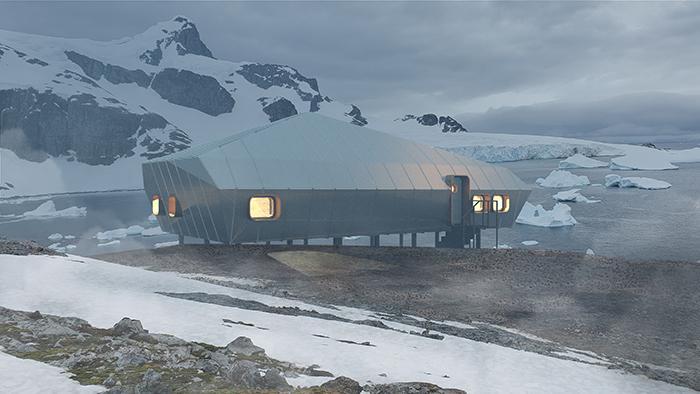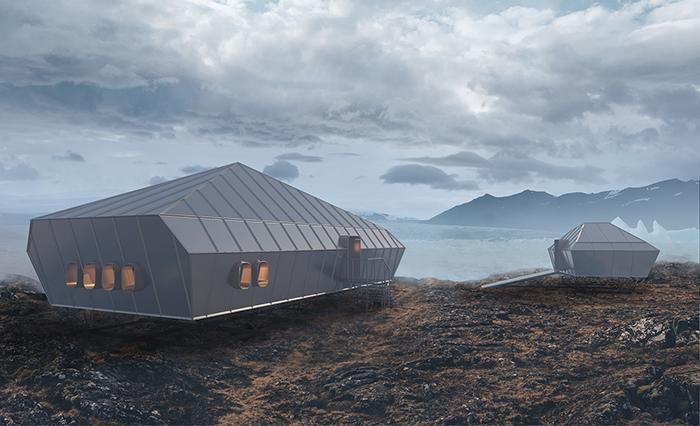The architects from BUT designed a new form of the CZ*ECO Nelson polar station
PRESS RELEASE

Strong wind, humidity, low temperature, high UV radiation and almost the impossibility of digging - all had to be taken into account by students and teachers from the Faculty of Architecture at BUT, who started designing a research station in Antarctica. The building, which was acquired four years ago by a private Czech Antarctic Endowment Fund, is intended to serve scientists as a warehouse, laboratory and small hostel.
The station, formerly known as Eco-Nelson, is located on Nelson Island in the South Shetland Islands and is conveniently located especially for polar explorers who continue on to J. G. Mendel Station, where Czech scientists go every year. However, the current state of the 30-year-old Eco-Nelson station does not allow it to be fully utilized. "These are old cooling boxes from Russian ships that the original owner transported there. There is insulation inside the tin boxes, but mould got there. There is no mould itself in Antarctica, but there is a problem with high humidity in coastal areas. Some stations will even fall apart over time due to mould, "Martin Kaftan, the head of the Department of Experimental Creation at the BUT Faculty of Architecture, summarizes the current situation.
Czech polar explorers would like to use the station as a warehouse and research facility in the future. The seaside area where it is located is full of life. At the same time, the coast is characterized by strong winds bringing abrasive particles and, as on the rest of the continent, amplified UV radiation. Building materials therefore degrade rapidly and their selection is crucial for architects. "We obtained meteorological measurement data from the nearest station. We performed computer simulations to find the optimal form. An aerodynamic shape was created to reduce air resistance, but at the same time not to create leeward sides where snow would accumulate. In Antarctica, the sun shines from the north and in the summer almost all day, but it is low. Therefore, our design of the station also took into account the optimal placement of solar panels," Kaftan points out some specifics of the construction in such extreme conditions.
The architects also collaborate with Alois Suchánek, who has experience in the construction of polar stations. "Mr. Suchánek says that he has several principles: any part must be able to be carried by 4 guys, the minimum screw size is fourteen and the hardware store is far away. Based on this, we invented a station composed of plywood parts. These are boxes that can be assembled in the Czech Republic and just lock themselves in place on the spot. They will come to Antarctica filled with thermal insulation that is resistant to mould. We also devise anchoring to a moving ground. One option is to build the foundation as a grate made of sleepers, which is a solution from Mendel's station, or to use metal cages (gabions) to fill the stones on site," noting that in Antarctica. In addition to the building itself, the architects are also thinking about obtaining energy. So far, the most probable seems to be solar panels and a generator, which would also be able to use waste heat to heat the station. A useful curiosity is the considered equipping of the station with an ecological combustion toilet, which turns waste into ash.

The architects want to create a prototype of a smaller warehouse in the newly built robotic laboratory at the Faculty of Architecture and then best offer it, for example, to administrators of one of the mountain areas, where people would test it as a shelter in similarly extreme conditions, at least in terms of humidity.
"The goal of the Czech Antarctic Endowment Fund is to support everything related to Czech scientific activities in the polar regions and in the Antarctic area in particular. CAEF significantly contributed to resolving the complicated legal situation surrounding the originally private Eco-Nelson base in the international area of the Antarctic Protected Area, when it took over its ownership from its founder and contractually transferred responsibility for operation to Masaryk University, or the Czech Antarctic Program, which is based at its Faculty of Science. After this step, the station was brought into an acceptable state from the point of view of environmental protection. The station was equipped with mandatory fire, rescue and communication equipment, a new boat, a temporary generator, etc. were purchased. Thus, the idea arose in cooperation with the Czech Antarctic Research Program and BUT to start project work to repair this installation, newly called CZ*ECO Nelson. Our goal is to build a modern scientific polar station promoting Czech science and technology of the 21st century. CAEF will carry out all the necessary activities for the implementation of this project", Dušan Jamný, CAEF director, said.
Pavel Kapler, the manager of the Czech Antarctic Research Program (MU), is also pleased with the cooperation: “Antarctica is a continent full of completely unexpected obstacles that teach us new things and practices, but also opportunities. I am very pleased that the cooperation of our program with CAEF and BUT can contribute to this space with something that has the potential to significantly raise the profile of the Czech Republic, its science and technology and in this case also architectural art."
| Published | |
|---|---|
| Link | https://www.vut.cz/en/but/f19528/d208959 |